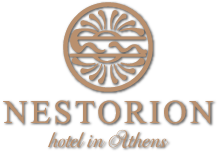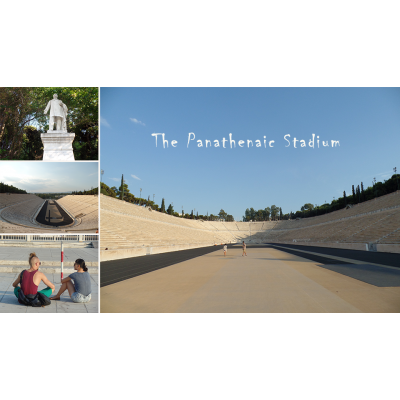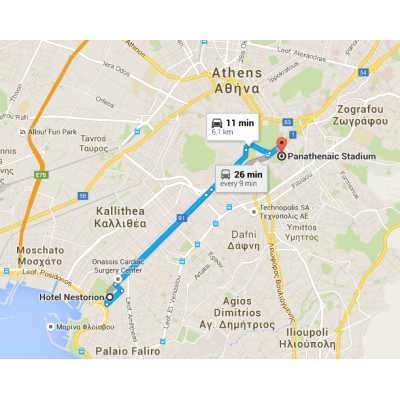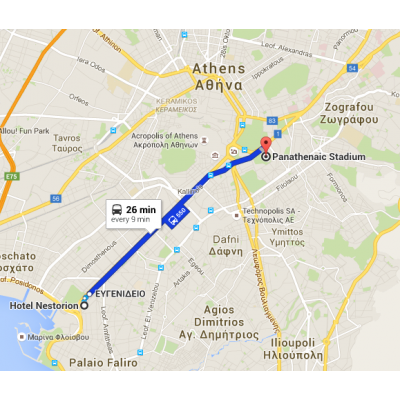Panathenaic Stadium
the budget hotel in athens
"The Panathenaic Stadium is located in the heart of Athens on the site of an ancient stadium and for many centuries hosted games in whiche nude athletes competed (gymnikoi agones) in track events, athletics championships as we would call them today. In the forth century BC, during the archonship of Lykourgos, the building of a stadium was included in the public works carried out in Athens. The ravine running between Ardettos Hill and the low high opposite, in a idyllic setting on the banks of the River Ilissos, was deemed to be a ideal location. This was private land but its owner , Deinias, conceded it to the State for the construction of a Stadium. major earth-removal works transformed the ravine in a space for contests, with the features of the Greek stadium, of parallelogram shape with entrance at one narrow and room for the spectators on the earth slopes of the other three sides. Lykourgos Stadium was used for the first time during the celebration of the Great Panathinaia in 330/329 BC, to host gymnikoi agones, which had since early times been held in a space to the south of Athens,
In Roman times, during the reign of Emperor Hadrian, AD 117-138, significant works werrw carried out in the Stadium between AD 139 and 144, thanks to the generosity of the orator and magnate Herodes son of Atticus. These resulted in two main changes to the initial form: the conversion of the rectilinear shape to horseshoe shape by adding the sphendone, characteristic element of Greek Stadia in Roman times, and the installation in the space for spectators of rows of seats (edolia) of white pentelic marble. A vaulted passage under the east retaining wall terminated at the back of the stadium and the temple of Tyche/Fortuna was built on top of Arthettos Hill. The whole space was adorned with splendid statues. The Athenians were justly proud of the panathenaic Stadium, which was unrivalled in the world. For many years, the tomb of Herodes Atticus dominated the hilltop left to the entrance. With the prevailing of Christianity and the prohibiting of pagan celebrations and the barbarous spectacles of Roman times, such as bloody gladiatorial duels and contests with wild beasts, the Panathenaic Stadium gradually presented a sad picture of dereliction, as the splendid marbles were incorporated into Athenian buildings.
A first attempt at reviving the idea o Olympic Games was the Zappeian Olympiads , exhibitions of Greek products, in connection with which athletics events were organized in the Panathenaic Stadium, in 1870 and 1875. This idea was brought to fruition by Baron Pierre de Coubertin, who organized the International Olympic Conference in Paris in 1894. President of the Conference was Demetrios Vikelas, who persuaded the delegates that the first modern Olympic Games should be held in the Greek Capital in 1896. The Panathenaic Stadium was chosen to host the Olympic Games. The enormous expense of reconstructring the Stadium was undertaken bu Georgios Averoff, whose marble portrait statue stands to the right of the entrance to the Stadium. Thanks to evidence uncovered in archaeological excavations during the nineteenth century, the rebuilding of the stadium from the Pentelic marble is distinguished by the high degree of fidelity to the ancient monument of the second century AD.
The first modern Olympic Games were a resounding success. It was then that the Olympic Hymn, with lyrics by poet Costis Palamas and music by composer Spyros Samaras, was heard for the first time. The victor in the Marathon race, the most popular contest, was the Greek Spyros Louis. Throughout the twentieth century the Panathenaic Stadium hosted diverse events. In the Athens 2004 Olympic Games it experienced moments of suspense and emotion during the archery contests and the finishing line of the Marathon race. A creation of the Athenians, as its name proudly proclaims the Panathenaic Stadium has been the venue for noble competition and fair play, of mind and of body, since Antiquity.
The Stadium is named after the length of the name of the track, one stade, a measure of length in Antiquity, equivalent to approximately 185 meters.
The area for the spectators, which could accommodate over 68.000 persons, was divided in two tiers by diazoma at the level of the 24th row of the seats Built stairways form the cunei, the continuous curvature of which secures optimum disability of the track.
A passage between the front row of seats and the protective parapet covers an underground conduit for draining off rainwater".
Source: Hellenic Olympic Committee, Aristea Papanicolaou - Christensen, Historian - Archaeologist.
Route Nestorion - Panathenaic Stadium: https://goo.gl/maps/Ye2RX
In Roman times, during the reign of Emperor Hadrian, AD 117-138, significant works werrw carried out in the Stadium between AD 139 and 144, thanks to the generosity of the orator and magnate Herodes son of Atticus. These resulted in two main changes to the initial form: the conversion of the rectilinear shape to horseshoe shape by adding the sphendone, characteristic element of Greek Stadia in Roman times, and the installation in the space for spectators of rows of seats (edolia) of white pentelic marble. A vaulted passage under the east retaining wall terminated at the back of the stadium and the temple of Tyche/Fortuna was built on top of Arthettos Hill. The whole space was adorned with splendid statues. The Athenians were justly proud of the panathenaic Stadium, which was unrivalled in the world. For many years, the tomb of Herodes Atticus dominated the hilltop left to the entrance. With the prevailing of Christianity and the prohibiting of pagan celebrations and the barbarous spectacles of Roman times, such as bloody gladiatorial duels and contests with wild beasts, the Panathenaic Stadium gradually presented a sad picture of dereliction, as the splendid marbles were incorporated into Athenian buildings.
A first attempt at reviving the idea o Olympic Games was the Zappeian Olympiads , exhibitions of Greek products, in connection with which athletics events were organized in the Panathenaic Stadium, in 1870 and 1875. This idea was brought to fruition by Baron Pierre de Coubertin, who organized the International Olympic Conference in Paris in 1894. President of the Conference was Demetrios Vikelas, who persuaded the delegates that the first modern Olympic Games should be held in the Greek Capital in 1896. The Panathenaic Stadium was chosen to host the Olympic Games. The enormous expense of reconstructring the Stadium was undertaken bu Georgios Averoff, whose marble portrait statue stands to the right of the entrance to the Stadium. Thanks to evidence uncovered in archaeological excavations during the nineteenth century, the rebuilding of the stadium from the Pentelic marble is distinguished by the high degree of fidelity to the ancient monument of the second century AD.
The first modern Olympic Games were a resounding success. It was then that the Olympic Hymn, with lyrics by poet Costis Palamas and music by composer Spyros Samaras, was heard for the first time. The victor in the Marathon race, the most popular contest, was the Greek Spyros Louis. Throughout the twentieth century the Panathenaic Stadium hosted diverse events. In the Athens 2004 Olympic Games it experienced moments of suspense and emotion during the archery contests and the finishing line of the Marathon race. A creation of the Athenians, as its name proudly proclaims the Panathenaic Stadium has been the venue for noble competition and fair play, of mind and of body, since Antiquity.
The Stadium is named after the length of the name of the track, one stade, a measure of length in Antiquity, equivalent to approximately 185 meters.
The area for the spectators, which could accommodate over 68.000 persons, was divided in two tiers by diazoma at the level of the 24th row of the seats Built stairways form the cunei, the continuous curvature of which secures optimum disability of the track.
A passage between the front row of seats and the protective parapet covers an underground conduit for draining off rainwater".
Source: Hellenic Olympic Committee, Aristea Papanicolaou - Christensen, Historian - Archaeologist.
Route Nestorion - Panathenaic Stadium: https://goo.gl/maps/Ye2RX





